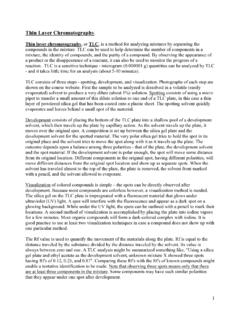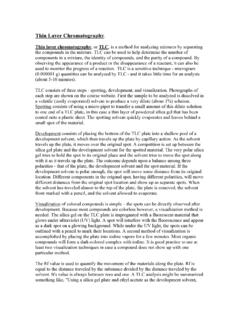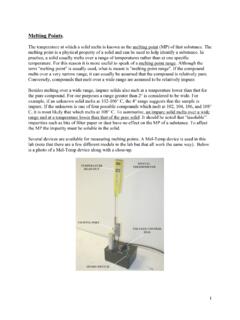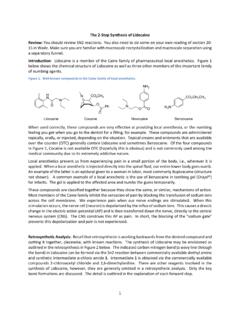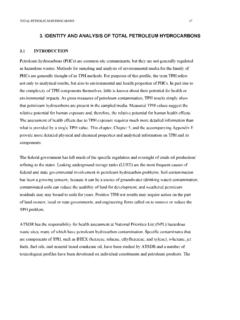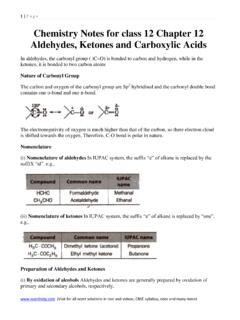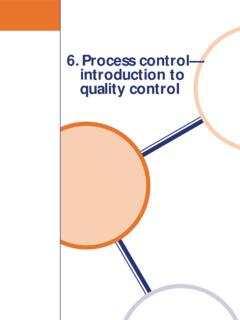Transcription of Identification of an Unknown – Alcohols, Aldehydes, and ...
1 Identification of an Unknown : Alcohols, Aldehydes, and ketones How does one determine the identity and structure of an Unknown compound? This is not a trivial task. Modern x-ray and spectroscopic techniques have made the job much easier, but for some very complex molecules, Identification and structure determination remains a challenge. In addition to spectroscopic information and information obtained from other instrumental methods, chemical reactions can provide useful structural information, and physical properties can contribute significantly to confirming the identity of a compound. In this experiment, you will be asked to identify an Unknown liquid, which will be either an alcohol, aldehyde, or ketone .
2 Identification will be accomplished by carrying out chemical tests , called classification tests , preparing a solid derivative of the Unknown and determining its melting point (MP), making careful observations, and analyzing the NMR spectrum of the Unknown . the carbonyl group O O. R OH R H R R. alcohol aldehyde ketone A list of alcohols, aldehydes, and ketones , along with the MP of a solid derivative of each compound, is posted on the website. The Unknown will be one of these listed compounds. If one can determine to which functional group class (alcohol, aldehyde, or ketone ) the Unknown belongs, two of the three lists need not be considered and the task will be greatly simplified.
3 To accomplish this, classification tests will be carried out. First, consider some general ways in which alcohols, aldehydes, and ketones react. 1. CLASSIFICATION tests , which are simple chemical reactions that produce color changes or form precipitates, can be used to differentiate alcohols, aldehydes, and ketones , and also to provide further structural information. Because color plays such an important role in this experiment, a separate handout on this topic is available on the course website. 2,4-Dinitrophenylhydrazine: Aldehydes and ketones react with 2,4-dinitrophenylhydrazine reagent to form yellow, orange, or reddish-orange precipitates, whereas alcohols do not react.
4 Formation of a precipitate therefore indicates the presence of an aldehyde or ketone . The precipitate from this test also serves as a solid derivative. A discussion on derivatives will be given later in this handout. The mechanism of this reaction is that of imine formation and can be found in any organic lecture text. NO2 NO2. H H. O N a series of steps N. + H 2N R N. R. NO2 NO2. a ketone if .. R = carbon a 2,4-DNP hydrazone an aldehyde if .. R = H 2,4-DNP. (generally a solid). Ceric Ammonium Nitrate (CAN): Alcohols react with this yellow reagent to produce a color change (from yellow to red), but the carbonyl group is unreactive. This is a good experiment to test for the presence of an alcohol or to prove the absence thereof.
5 Note that changing the groups attached to certain inorganic ions such as Ce4+ results in a change to the electronic structure, which results in a color change. Production of a magenta color, therefore, indicates the presence of an alcohol group. The 2 ammonium cations are present as spectators and do not participate. 2- + 2- O. R OH (NH4)2[Ce(NO3)6] R Ce(NO3)5. an alcohol CAN, a yellow solid an alkoxy cerium(IV) derivative Schiff's Reagent: Before looking at the reaction of Schiff's reagent, consider a much simpler system. The sulfur in the bisulfite ion acts as a nucleophile and adds to the carbonyl carbon. Because this is such a bulky nucleophile, it will add only to a relatively sterically unhindered carbonyl.
6 This requires the carbonyl to be part of an aldehyde in which one of the R groups is the very small hydrogen, or a ketone having small R' groups. A ketone having large groups attached to the carbonyl will not react with bisulfite. OH O O R. +. S O S OH. O O R R. O R. aldehyde or sterically bisulfite addition bisulfite unhindered ketone complex Aldehydes react with Schiff's reagent to produce a color change (magenta-colored addition product). In the same way, the Schiff reagent acts as a nucleophile that adds to the carbonyl group of an aldehyde. 2. Because this nucleophile is extremely bulky, a ketone , which is more sterically crowded than an aldehyde at the carbonyl carbon, does not react with Schiff's reagent, and thus does not produce the magenta color.
7 Production of the magenta color therefore indicates that the Unknown is an aldehyde and not a ketone . Note that generally, more extended systems of conjugation lead to colored compounds. Whereas the Schiff reagent itself has a limited system of conjugation, the adduct with an aldehyde has an extended system of conjugation, resulting in a highly colored compound. More can be found on color in the supplemental handout on the course website. SCHIFF TEST FOR ALDEHYDES. NHSO2H (Very Hindered Nucleophile). R. O. H Aldehyde HO2 SNH2 SO3H ( ketone is too hindered - does not react). R. Schiff Reagent NHSO2 C OH. Limited Number of 3 molecules H. Resonance Forms of aldehyde NHSO2H R.
8 COLORLESS HO C SO2NH. H. R. Schiff Adduct Highly Conjugated NHSO2 C OH. (13 resonance forms) H. MAGENTA COLOR. The results of these classification tests will allow the Unknown to be classified as an alcohol, an aldehyde, or a ketone . Additional structural information can be obtained from the iodoform test. Iodoform Reaction: The iodoform test indicates the presence of an aldehyde or ketone in which one of the groups directly attached to the carbonyl carbon is a methyl group. Such a ketone is called a methyl ketone . In the iodoform test, the Unknown is allowed to react with a mixture of excess iodine and excess hydroxide. Hydrogens alpha to a carbonyl group are acidic and will react with the hydroxide to form the anion, which then reacts with iodine to form an alpha-iodo ketone .
9 In a methyl ketone , all three alpha hydrogens are substituted by iodine in this way to form the triiodo compound, which then reacts with more hydroxide to form the carboxylate salt plus iodoform, a yellow precipitate. Formation of a yellow precipitate therefore indicates the presence of a methyl group directly attached to the carbonyl. O O O O O. Ph Ph Ph examples of methyl ketones ketones, but not methyl ketones 3. The mechanism of the iodoform reaction is that of alpha-halogenation of a carbonyl compound under basic conditions, followed by nucleophilic displacement of the resulting triiodomethyl group by hydroxide. The mechanism is outlined below where all inorganic by-products are omitted for clarity.
10 O O O. I2. H H I. + OH + I I. H H. H H H. O O O O. I I I I I + I OH. I HO I. I I I I H H. OH HO O O O. I I. I +. H +. I O I I O I I. I. iodoform, good leaving group a precipitate DERIVATIVE FORMATION: Simple chemical reactions that convert a liquid into a solid derivative provide another key piece of information. Why is it that the liquid Unknown changes to a solid derivative? The Unknown has a relatively low molecular weight (MW) and relatively low polarity, causing it to be a liquid at room temperature (RT). Derivatives are chosen to have a high MW and very high polarity, causing them to be solids at RT. The solid derivative is purified by recrystallization, and its MP.

